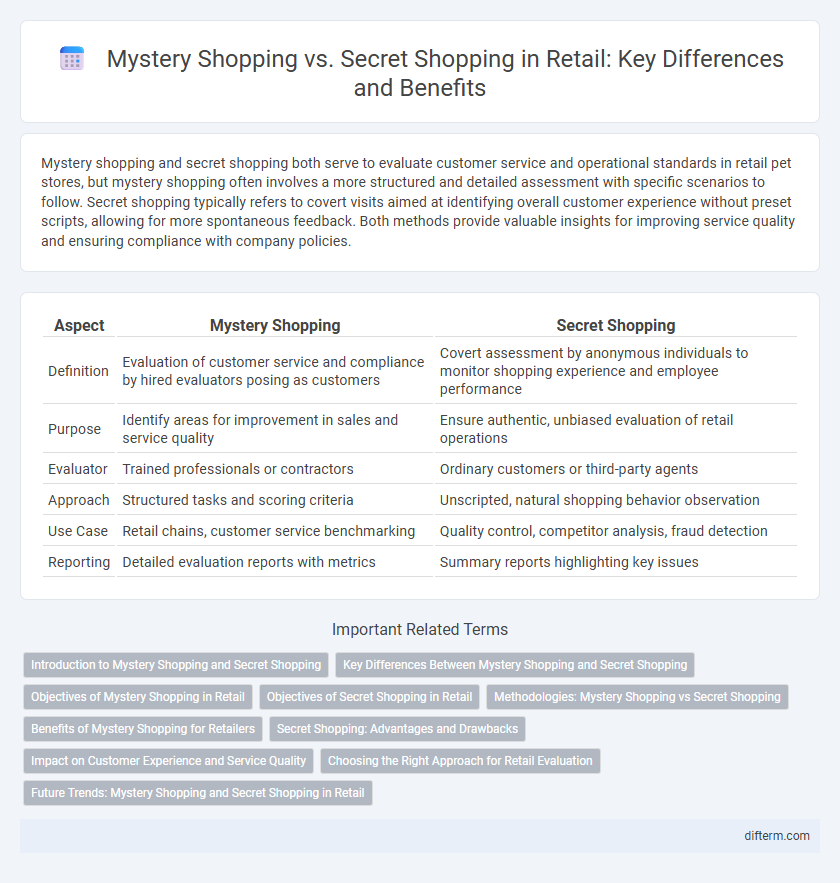Mystery shopping and secret shopping both serve to evaluate customer service and operational standards in retail pet stores, but mystery shopping often involves a more structured and detailed assessment with specific scenarios to follow. Secret shopping typically refers to covert visits aimed at identifying overall customer experience without preset scripts, allowing for more spontaneous feedback. Both methods provide valuable insights for improving service quality and ensuring compliance with company policies.
Table of Comparison
| Aspect | Mystery Shopping | Secret Shopping |
|---|---|---|
| Definition | Evaluation of customer service and compliance by hired evaluators posing as customers | Covert assessment by anonymous individuals to monitor shopping experience and employee performance |
| Purpose | Identify areas for improvement in sales and service quality | Ensure authentic, unbiased evaluation of retail operations |
| Evaluator | Trained professionals or contractors | Ordinary customers or third-party agents |
| Approach | Structured tasks and scoring criteria | Unscripted, natural shopping behavior observation |
| Use Case | Retail chains, customer service benchmarking | Quality control, competitor analysis, fraud detection |
| Reporting | Detailed evaluation reports with metrics | Summary reports highlighting key issues |
Introduction to Mystery Shopping and Secret Shopping
Mystery shopping and secret shopping are invaluable tools in retail for evaluating customer service quality and compliance with company standards. Mystery shopping involves trained evaluators assessing retail environments anonymously, while secret shopping typically refers to unannounced visits by either employees or third-party agents to monitor specific operational aspects. Both methods provide actionable insights that help retailers enhance customer experience and optimize store performance.
Key Differences Between Mystery Shopping and Secret Shopping
Mystery shopping involves hired evaluators visiting retail stores to assess customer service, product quality, and compliance with brand standards, providing detailed reports based on pre-set criteria. Secret shopping, often used interchangeably, typically emphasizes covert observation with less structured feedback, focusing more on general customer experience and employee behavior without formal evaluation metrics. Key differences include the level of evaluation detail, reporting format, and the specific objectives aligned with retail performance and brand integrity.
Objectives of Mystery Shopping in Retail
Mystery shopping in retail aims to evaluate the quality of customer service, ensure compliance with brand standards, and identify areas for operational improvement. This method provides objective insights into employee performance and customer experience by simulating real shopping scenarios. Retailers use these findings to enhance training programs, improve store environments, and increase overall customer satisfaction.
Objectives of Secret Shopping in Retail
Secret shopping in retail primarily aims to evaluate customer service quality, ensure compliance with brand standards, and identify operational strengths and weaknesses. By simulating real customer experiences, retailers gain actionable insights into employee behavior, product presentation, and store cleanliness. This method supports targeted training initiatives and enhances overall customer satisfaction, directly impacting sales performance.
Methodologies: Mystery Shopping vs Secret Shopping
Mystery shopping involves trained evaluators posing as regular customers to assess specific service criteria using standardized checklists and detailed reporting tools. Secret shopping employs covert observation techniques where shoppers discreetly gather qualitative data on employee behavior and store ambiance without revealing their identity. Both methodologies emphasize anonymity but differ in structure, with mystery shopping offering more formalized metrics and secret shopping focusing on spontaneous customer experience insights.
Benefits of Mystery Shopping for Retailers
Mystery shopping provides retailers with objective insights into customer service quality, store cleanliness, and overall shopping experience, enabling targeted improvements. Retailers gain valuable data on employee performance and adherence to company standards, helping to enhance staff training and boost customer satisfaction. This method also assists in identifying operational weaknesses, ensuring consistency across multiple store locations and improving brand reputation.
Secret Shopping: Advantages and Drawbacks
Secret shopping offers retailers an unbiased evaluation of customer service and store conditions by providing authentic insights into employee performance and operational standards. Advantages include real-time feedback, enhanced staff accountability, and the ability to identify training needs without alerting employees, which leads to more accurate assessments. Drawbacks involve potential ethical concerns over employee privacy, possible inconsistencies due to subjective evaluations, and the need for extensive planning and resources to implement effectively.
Impact on Customer Experience and Service Quality
Mystery shopping and secret shopping both serve as powerful tools for assessing and improving customer experience and service quality in retail environments, yet mystery shopping typically involves structured evaluations by professional assessors, providing consistent, data-driven insights into employee performance and adherence to brand standards. Secret shopping often includes unannounced visits by actual customers or trained evaluators, capturing authentic interactions and real-time service dynamics that highlight genuine customer perceptions. Integrating both methods allows retailers to identify gaps in service delivery, enhance employee accountability, and ultimately drive higher customer satisfaction and loyalty.
Choosing the Right Approach for Retail Evaluation
Mystery shopping and secret shopping both serve as effective tools for retail evaluation, with mystery shopping often involving third-party evaluators to provide unbiased insights, while secret shopping may be conducted internally for quick feedback. Selecting the right approach depends on the specific retail goals, such as assessing customer service quality, compliance with store standards, or operational efficiency. Integrating detailed performance metrics with customer experience analysis ensures a comprehensive evaluation that drives strategic improvements in retail operations.
Future Trends: Mystery Shopping and Secret Shopping in Retail
Emerging technologies like AI-driven analytics and real-time data collection are transforming mystery shopping and secret shopping, enabling retailers to gain deeper insights into customer experiences and employee performance. Future trends indicate a shift towards integrating mobile apps and augmented reality to make secret shopping more immersive and efficient. Enhanced automation and predictive analytics will allow retailers to proactively address service gaps, driving higher customer satisfaction and operational excellence.
Mystery Shopping vs Secret Shopping Infographic

 difterm.com
difterm.com